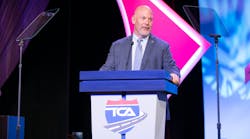Will you be landing in San Diego this weekend for the American Truck Associations' Management Conference & Exhibition and want to know the government and regulatory issues that trucking industry stakeholders will be talking about there? David Heller, senior VP of safety and government affairs for the Truckload Carriers Association (TCA), had you covered with an Oct. 20 online overview.
Heller did a deep dive during the TCA webinar, with TCA Government Affairs Manager Caitlin Smith moderating, that touched on a lot of what trucking already is talking about:
- AB5 in California, subject of an Oct. 23 session at the annual American Trucking Associations conference. “AB5 is the law of the land in California,” Heller said, and rules in other states and the U.S. Department of Labor could threaten the independent contractor model.
- The Federal Motor Carrier Safety Administration’s new chief, Robin Hutcheson. She is scheduled to speak at MC&E on Oct. 22. “She is engaged” on the issues between FMCSA and trucking, Heller said, and she “wants to work with the industry, instead of against” it. Transportation Secretary Pete Buttigieg also is set to address MC&E on Oct. 25.
- The reincarnated speed limiter rulemaking.
- The driver population “perfect storm” with recruiting efforts swirling amid the COVID-19 recovery, falling CDL school enrollments, and bites into the population by federal Drug & Alcohol Clearinghouse positive tests—all against the backdrop of the growing driver shortage (which odds are will headline the American Transportation Research Institute’s Oct. 22 reveal of the results of its annual top industry issues survey).
- The federal under-21 pilot program, which is underway and permitting up to 3,000 drivers between the ages of 18 and 20 to cross their state lines and participate in interstate commerce. “We can get answers out of this pilot that can hopefully open up this demographic,” Heller said during the webinar. “The biggest question that gets answered is do they drive more safely than their older counterparts.”
Midterm election mode and FMCSA
Heller noted that Congress is now functioning in a "midterm election mode" where legislative activity is quiet in advance of hotly contested elections on Nov. 8. However, soon after the elections, Heller noted, Congress will go into its lame-duck session, where transportation and trucking issues will undoubtedly come up. But “everything that’s been done recently” on the legislative end has been transferred over to FMCSA for implementation.
Those include provisions of the Infrastructure Investment and Jobs Act, which mandates a study into the effectiveness, development, and implementation of side underride guards, a new Large Truck Crash Causation Study, the under-21 apprenticeship program, an ELD oversight survey, a “truck leasing task force” to look at leasing practices in trucking, broker guidance, and a review on transitioning the U.S. fuel tax system to fund nationwide infrastructure with a vehicle miles traveled tax (VMT) that takes into account ever-popular electric and other alternative vehicles that don’t burn diesel.
Heller noted that FMCSA’s Hutcheson, who was confirmed by the Senate on Sept. 22, is inheriting the National Roadway Safety Strategy, which goes to lengths to note the increase in roadway fatalities since 2019. Even newer data from the National Highway Traffic Safety Administration (NHTSA) noted a 10% increase in fatalities since 2020 and that deaths involving at least one large truck were up 13% in 2021.
TCA, the regulatory affairs chief noted, has put its support behind safety technology like autonomous emergency braking (AEB), rear underride guards (for which a final NHTSA rule was published July 15 in the Federal Register), lane-departure warning systems, and speed limiters—which have drawn controversy, especially within the owner-operator and small-fleet community.
Heller returned to the subject of Congress, in and out of where there has been “a ton of talk” about truck parking, the leading issue among professional drivers in ATRI’s 2021 survey, saying legislative action and funding for more parking nationwide might emerge from the lame-duck session.
Simmering speed-limiter debate
During the TCA webinar, Heller noted that the speed-limiter rule received 16,000 comments on the Federal Register, second only to the comment period for perhaps FMCSA’s all-time most controversial rulemaking: hours of service.
He also said that the proposed speed-limiter rulemaking doesn’t provide a mandated speed limit that would have to be programmed into every heavy commercial truck’s electronic engine control unit. He surmised that such an MPH limit would come from FMCSA in a supplemental notice of proposed rulemaking (NPRM), perhaps not any sooner than next fall.
He also predicted language in that supplemental NPRM might draw inspiration from last year’s Cullum Owings Large Truck Safe Operating Speed Act, introduced in the Democrat-led House, that proposed a governed speed limit of 65 miles per hour for commercial trucks. TCA supported Cullum, Heller noted, as it does the new speed-limiter proposal. “We’re waiting to see how speed shakes out.”
Heller noted two other points related to speed limiters—that the under-21 pilot program requires trucks operated by participating younger drivers to be MPH-governed, but that 79% of respondents in a recent survey opposed speed limiters. The outcry seems to have been the loudest from the owner-operator and small-fleet community. Many larger fleets, including numerous TCA member carriers, already govern the speeds of their rigs.
AB5 causing waves beyond California
“These types of laws in California generally do have a ripple effect,” Heller said, meaning Labor Department rules under the Biden administration and upcoming laws in states such as Oregon and Washington might follow AB5’s path in radically changing the rules for independent contractors.
Carriers in California and elsewhere, he observed, are responding with four different strategies to counter AB5: Fully conceding and making contractors into employees, establishing brokerages where they get their own authority to operate, “deadheading” out of California, or implementing what has become known as the “two-check solution.” There are variations on this solution, but it basically calls on fleets to employ drivers while cutting separate checks for their expenses and for renting their vehicles. “AB5 is limiting freedom of choice in trucking in California,” Heller stated.
Much to do about drivers
“We’ve always operated under a driver shortage,” Heller said, noting during his TCA webinar the widely circulated statistic that the industry might be down 160,000 in just a few years, noting that Canada also is feeling the effects of the shortage.
He said this problem had gone largely unnoticed by the public until recently. “When you start to see empty store shelves, it starts to affect us all. We have to acknowledge how essential truck drivers are.”
In terms of driver numbers, Heller noted what he called a “net-zero effect,” where the influx of drivers is offset by those same drivers leaving the industry shortly thereafter.
In the last two years, smaller fleets and owner-operators generally poured into trucking to take advantage of surging spot market rates, but they are exiting almost as quickly as spot rates have receded, business conditions have soured, and fuel prices have soared. Heller displayed FMCSA data that showed the number of operating authority applications surging last year into 2022, followed by a countering increase later this year in revocations. The data, he said, show that "many are coming into the industry, then coming out."
The clearinghouse and drug testing
Heller also said during another portion of the Oct. 20 webinar that the effects of the Drug & Alcohol Clearinghouse (DAC) on driver numbers cannot be ignored, though everyone in trucking recognizes the benefits to safety of the federal system of substance-abuse testing and remediation.
According to clearinghouse data, more than 80,000 CDL-holders have tested positive but have not entered the return-to-duty process mandated by the DAC. “Those are people who are leaving the industry and working elsewhere,” he said.
He also covered the debate over drug-testing methods accepted by the clearinghouse during his talk.
The DAC only admits results from urinalysis, but the U.S. Department of Transportation sanctioned the testing of oral fluid in DOT-regulated workplaces—including trucking—in a proposed rulemaking this year, so that testing method may come to be accepted by the clearinghouse.
More controversial is hair-follicle testing. A group of large freight haulers led by The Trucking Alliance this summer asked the government to sanction hair testing for the DAC, a request that is still under review but one that Heller has personally endorsed.
“The results of hair testing are certainly proving themselves true,” he told the webinar, citing data from a recent study that showed 403 drivers testing positive for prohibited substances via urinalysis while, from the same pool of drivers, 4,362 positives occurred when their hair was screened.
To access a recording of the Oct. 20 webinar, visit TCA's website.




